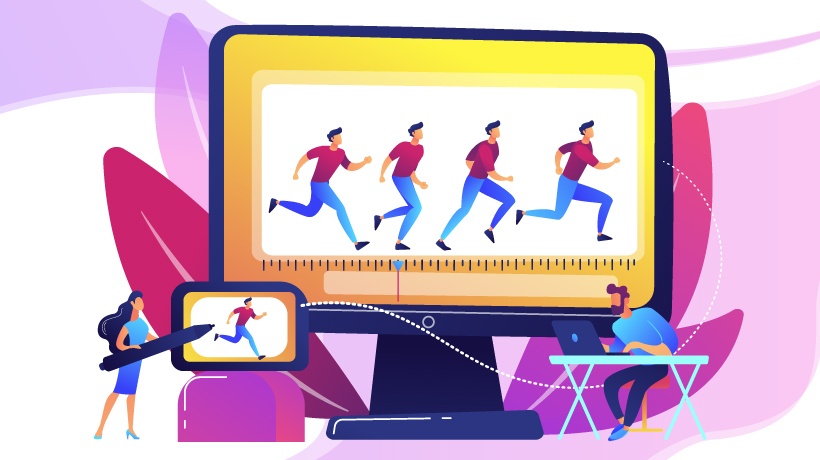Use Animation To Increase Online Course Completions Rates
It’s not difficult to search for how to improve the completion rates of your online course. Truly, the internet just gives you a bunch of solutions to just follow. However, they don’t show you what makes the completion rates for online courses so low and how to start with it. In this article, we will bring you to the root of the problem and give you an optimal solution to solve it.
Understanding Why Your Online Course Completion Rate Is Low
Nowadays, a low completion rate is one of the biggest "headaches" for all creators. Truly, many people evaluate the success of your eLearning course through its completion rate. In other words, if there are many learners dropping your course easily, perhaps you are facing certain issues listed below:
1. Lack Of Incentive
In the traditional classroom, the consequence of dropping out is having to attend the class again and pay extra money to re-enroll. However, it seems like there is no negative incentive if learners quit an online class. To be more specific, when a learner stops an online course:
- First, there is little or no damage involved in skipping class when there is no punishment or required extra course.
- Next, dropping out won’t affect the learners’ degree when there is no fixed curriculum in eLearning.
- Finally, no one will blame learners for not finishing the course.
Furthermore, some online courses do not provide any positive incentives for learners to motivate them to finish the lesson.
- First, learners do not receive any motivation from instructors to encourage them to complete the course.
- Second, there is no target or achievement for learners when they reach the end of the learning progress.
For that reason, some learners don't find it necessary to complete the course. Moreover, the difference between a regular classroom and an online course is that an online course has a very diverse public. Specifically, many learners are not students, therefore studying is not their main activity. Therefore, an online course is just an extra supplement for their job but does not require completion to benefit them. In the end, it leads to the low completion rate in an online course.
2. Optional Enrollment
Truly, enrollment in an online course is not compulsory. Therefore, people are free to enter and take any random eLearning courses. In a physical classroom, enrollment is something that adds value to an overall program. However, in an online course, the attitude of learners toward enrollment is not serious so they could just casually forget about the course.
Furthermore, some people enroll in the course not for educational purposes. Perhaps, they just get into the course to fulfill their curiosity. Hence, it leads to a big amount of unreal registration in your online course. To be more specific, there will be lots of accounts in your course, but only a small amount of them are actually active. As a result, when you receive this statistic, the percentage of people entering your course is relatively low.
3. Lack Of The Unique
In general, people will pay much more attention to you when you have something different from others. In education, if an online course has a Unique Selling Point (USP), it has the potential to achieve a higher retention rate.
Statics show that in 2018 there were 11.4k online courses, and the number keeps growing fast. Therefore, your course is just one in a thousand of other eLearning courses out there on the market. And, if you can not differentiate yourself from other competitors, nobody will come to your course and want to finish it.
How Can Animation Improve Online Course Completion Rates?
Above, we have listed some reasons that may cause low completion rates for online courses. There are many ways to solve these problems. However, instead of finding many solutions for each case, you can use animation for multiple problems at once. So, how can animations do that? Check it out.
1. Animation Helps Increase Commitment
People mostly have a problem with participating in an online course. For this reason, as a creator, you need to come up with some solutions that can increase the commitment of learners. For example, you can set out some ground rules or require some extra money as punishment for not completing the course. However, these ways are too harsh and rigid for learners. A good way to do this is to apply animation to online courses to enhance students' concentration, this naturally increases the commitment. There are 2 animation methods: visualization and storytelling.
- First, with visualization, animation can capture learners’ attention and engage them in learning. Visualizing knowledge helps learners understand the information better. Moreover, beautiful visuals and design can increase learners’ desire to study.
- Meanwhile, with storytelling, you can keep students concentrated and help them learn. Furthermore, with this advantage, animation can stir up learners' curiosity and their desire to know what will happen next. Eventually, they will follow the story as a habit and keep track until it is finished. As a result, you can grow learners' commitment naturally and increase completion rates.
2. Applying Animation To Create Your Own Specialty
Being unique in the field is another solution to increase completion rates for online courses. Some courses use promotions in the course to create their specialty. To be more specific, they discount or provide some packages for learners after they finish the course. By doing this, learners are motivated to finish the course and take another one. However, this is just a temporary solution, which shouldn't continually be applied in the future.
With animation, you will have more space to create your uniqueness in the long term. Usually, you can add some pictures and icons to your lesson to make it more outstanding than a text-based course. However, it is not enough to increase the excitement of learners and their motivation to explore the lessons. Therefore, animation can do this by using colorful backgrounds, animated characters, and motion. For example, you could use Avengers characters to teach kids in primary school.
Furthermore, perhaps only in animation, you can easily set the tone for your lesson. By using the storytelling method, creators can show the feeling and the level of importance of different cases. In an animated video, learners can realize the danger of some situations by the expression of the animated characters, the speed of motion, the emotion of the voice over, and the sound effects. For example, in a medical video, learners can understand the pain level of the patient by the color, the patient’s expression, and the music from the animation.
Conclusion
To improve the completion rates for online courses, there are 3 important points that you need to remember:
- Learners have a low commitment to the course when they lack incentive.
- Your online course needs to be special compared to other courses out there.
- Animation is the optimal solution to increase the completion rate of an online course.
Hopefully, this article can help you find out your problems and apply the most suitable method to your online course.








